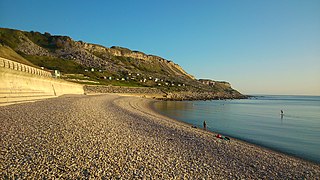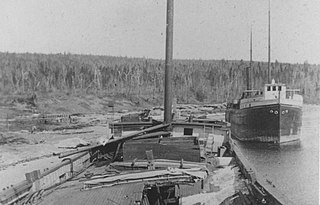
Goodwin Sands is a 10-mile-long (16 km) sandbank at the southern end of the North Sea lying 6 miles (10 km) off the Deal coast in Kent, England. The area consists of a layer of approximately 25 m (82 ft) depth of fine sand resting on an Upper Chalk platform belonging to the same geological feature that incorporates the White Cliffs of Dover. The banks lie between 0.5 m above the low water mark to around 3 m (10 ft) below low water, except for one channel that drops to around 20 m (66 ft) below. Tides and currents are constantly shifting the shoals.

Chesil Cove is a curved steep bank forming the south-east end of 29-kilometre (18 mi) Chesil Beach in Dorset, England. It is thus part of one of three large shingle structures in Britain, extending from West Bay to the Isle of Portland, the latter acting more firmly as a great barrier (groyne) which stops tidal action from washing the beach away and leads to the high depositions by wind and tide action forming the grand curved bank of this "cove". The "cove", bill and much of Chesil Beach give shelter from the prevailing winds and waves for much of Weymouth Bay, the town of Weymouth and the village of Chiswell. It forms part of the Jurassic Coast.

The Diosa del Mar was a wooden schooner that sank off of the coast of Catalina Island at 2:25 pm on July 30, 1990.

Cherry Venture was a 1600-ton cargo ship of Scandinavian origin. It ran aground on Teewah Beach in South East Queensland, Australia on 6 July 1973 and remained on the beach for 34 years until its removal in early 2007.
Blackpool and the Fylde coast have become a ship graveyard for a number of vessels over the years. Most of the shipwrecks occurred at or near Blackpool, whilst a few happened a little further afield but have strong connections with the Blackpool area. For this article, Blackpool means the stretch of coast from Fleetwood to Lytham St Annes.

The Nathan F. Cobb was a three-masted schooner named after the shipbuilder and founder of Cobb's Salvaging Company whose many rescues of stranded ships help lead to the formation of the United States Life-Saving Service. Despite its namesake's history of shipwreck rescues, the Nathan F. Cobb capsized in heavy seas on 1 December 1896 en route from Brunswick, Georgia to New York with a cargo of timber and cross ties. The cook and a shipmate drowned when they were swept overboard in violent seas. The crew righted the vessel by removing the three masts and they drifted for four days until they became grounded on a sandbar off Ormond Beach, Florida. Rescue attempts led to the drowning of volunteer Fred Waterhouse, whose body was never recovered, but no other crew members were lost. A plaque commemorates Fred Waterhouse's rescue efforts. The Cobb Cottage, a structure built using materials salvaged from the ship, is part of Ormond Beach's Historic Trail.

The SV Paul was a four-masted fore-and-aft rigged windjammer, launched in Seattle in 1919. Originally named Mount Whitney she was sold to new German owners in 1924 and renamed Margaret Sayer, finally in 1925 she was acquired by Flensburg owners and renamed 'Paul'.

Hydrabad was an iron cargo and passenger sailing ship, built in Scotland and launched in 1865. She was owned by several successive companies, and served until being wrecked off the coast of New Zealand in 1878. There were attempts to salvage her, but they all failed, and the wreck was left to deteriorate on the shoreline.

King Philip was a 19th-century clipper ship launched in 1856 and wrecked in 1878. The wreck of this ship is only rarely visible; very infrequently the timbers can be seen protruding from the sands of Ocean Beach, on the Pacific Ocean coast of San Francisco, California. The wreck is the "most complete remains of an American medium clipper." This is a shipwreck of one of many ships that were wrecked in and around San Francisco Bay.
Many ships have wrecked in and around San Francisco Bay. For centuries San Francisco Bay, with its strong currents, rocky reefs, and low fog conditions has experienced more than a hundred shipwrecks. Ever since San Francisco Bay was encountered during the land expedition of Gaspar de Portolà in 1769, it has been one of the most popular harbors.
Sam Cearns was a British ship-rigged sailing cargo ship and emigrant carrier, built in 1864. In 1871 she was wrecked near Tierra del Fuego after the crew members gallantly saved the crew of another windjammer Knight Errant.

Australasia was a wooden-hulled American Great Lakes freighter that served on the Great Lakes of North America between her construction in 1884 to her burning and sinking in 1896. On October 18, 1896, while loaded with coal, the Australasia sank in Lake Michigan near the town of Sevastopol, Door County, Wisconsin, United States, after burning off Cana Island. On July 3, 2013, the wreck of the Australasia was added to the National Register of Historic Places.

The George Spencer was a wooden lake freighter that sank on along with her schooner barge Amboy on Lake Superior, near Thomasville, Cook County, Minnesota in the Mataafa Storm of 1905. On April 14, 1994, the wrecks of the Spencer and the Amboy were listed on the National Register of Historic Places.

The Amboy was a wooden schooner barge that sank along with her towing steamer, the George Spencer on Lake Superior off the coast of Schroeder, Cook County, Minnesota in the United States. In 1994 the remains of the Amboy were added to the National Register of Historic Places.

The AmboyandGeorge SpencerShipwreck Site is an archeological shipwreck site which consists of the wrecks of the wooden bulk freighter George Spencer and the wooden schooner-barge Amboy. Both vessels were wrecked during the Mataafa Storm of 1905. In 1994 the site was added to the National Register of Historic Places.
The Hive Shipwreck is a heritage-listed shipwreck site of the Hive, a former convict transportation ship located approximately 40 metres (130 ft) off Bherwerre Beach, Jervis Bay Territory, Australia. It was added to the New South Wales State Heritage Register on 1 April 2010.
The Grape Shot is a shipwreck located off the coast of Plum Island, Wisconsin.













